Mordor
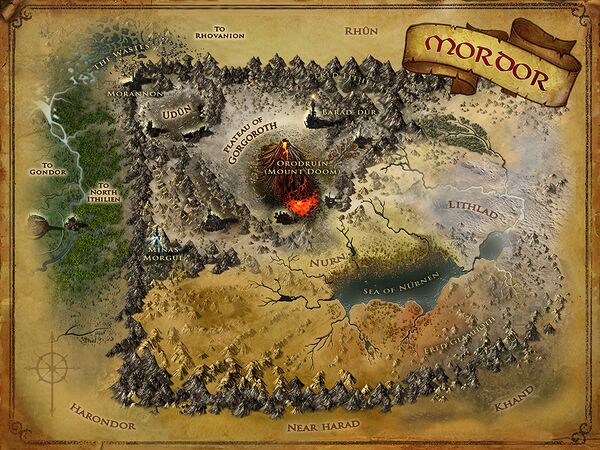
Mordor is a land in Middle-earth. It is the home of Sauron and the domain of his dark rule.
- "One does not simply walk into Mordor. Its black gates are guarded by more than just orcs. There is evil there that does not sleep, and the Great Eye is ever watchful.
It is a barren wasteland, riddled with fire, ash, and dust. The very air you breathe is a poisonous fume. Not with ten thousand men could you do this. It is folly."- — Boromir, The Lord of the Rings
- "One does not simply walk into Mordor. Its black gates are guarded by more than just orcs. There is evil there that does not sleep, and the Great Eye is ever watchful.
Description
- The area of Middle-Earth called Mordor is a relic of the devastating works of Morgoth before his banishment to the Void. Located in the southeast of Middle-earth to the East of the Anduin, the great river, it is the land covering the plateau formed by massive volcanic eruptions. In Sindarin it was given the name Mordor (the Black Land) before Sauron settled there, because of its volcano and its eruptions. Shelob had settled in Mordor long before Sauron.
- Mordor's geography is unique because of the three enormous mountain ridges surrounding it, on the North, the West and the South. These mountains both protected the land from an unexpected invasion by any of the people living in those directions and kept those living in Mordor from escaping. Mordor was a land of approximately rectangular shape, measuring some 600 miles east to west and 400 north to south. On all but its eastern borders, where it marched with Rhûn and Khand, it was surrounded by the mountains of the Ered Lithui and the Ephel Dúath.
- Offshoots of its mountain fences divided the land into two distinct regions, the barren uplands of Gorgoroth in the northwest, and the more fertile southern plain of Nurn, where the inland sea of Núrnen lay.
- In the far northwest of Mordor, where the mountains of the Ered Lithui and Ephel Dúath came together, lay a valley named Udûn (after the ancient fortress of darkness in the north of the World). This was the only break in Mordor's western mountain-defences, and Sauron built a great gate, the Morannon, at its mouth to protect his realm.
Locations
- Ephel Dúath (Sindarin) - the Mountains of Shadow - form the borders of Mordor on the west and south.
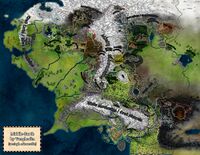
- Bordering North Ithilien and South Ithilien of Gondor on the west, they swing east to form the southern border of Mordor, separating Mordor from the Harad lands to the south. They were breached midway by the Morgulduin, a river of Gondor, forming the pass of Cirith Ungol.
- In the north-west corner of Mordor, the northern end of the Ephel Dúath forms one side of the pass of Cirith Gorgor. A narrow pass with sheer cliffs on either side where the two mountain ranges meet -- the Ephel Dúath coming up the west side of Mordor, and Ered Lithui across the north of Mordor -- across which the Morannon (Black Gate) was constructed by Sauron.
- A pass in their middle, Cirith Ungol, the Morgul Vale, originally led from the Crossroads outside of Osgiliath to Minas Ithil.
- Cirith Ungol is Sindarin for "Spider's cleft", from cirith ("cleft, pass") and ungol ("spider")
- Ered Lithui (Sindarin) - The Ash Mountains separate Mordor from Rhûn, this mountain range forms the northern border of Mordor.

Pronunciation: e'red lee'thui ('th' as in English 'myth', and 'ui' as in 'ruin', pronounced as a single syllable)
- Meeting with the Ephel Dúath in the north-west corner of Mordor it forms one side of the pass of Cirith Gorgor leading into the enclosed plain of Udûn.
- A spur forms one side of the pass of the Isenmouthe (also called Carach Angren) which encircles the valley of Udûn.
- A second spur of the Ered Lithui leads to the Plateau of Gorgoroth where Orodruin (Mount Doom) and Barad-dûr are located.
- Cirith Gorgor is the narrow pass between the Ephel Dúath and the Ered Lithui, sealed by the Morannon (the Black Gate) and guarded by Carchost and Narchost, the Towers of the Teeth. After the fall of Sauron, the Gate and the Towers collapsed, and the Conquest of Gorgoroth entered through the pass.
Dates: Constructed in the beginning of the World, ruined c.4,000 years before the beginning of the First Age Location: The far north of the World Pronunciation: oo'doon Meaning: The Sindarin form of an originally Quenya name, probably meaning 'Underworld'
- Udûn was the Sindarin name of the fortress of the first Dark Lord in the far north of the World. It was the first and greatest of his citadels, delved in the earliest days, the home to hosts of demons and monsters. From Udûn, the Dark Lord troubled the world for millennia. From there, he drove the Valar out of their dwelling-place in Middle-earth, and into the West. At the time of the awakening of the Elves, though, the Valar attacked Udûn in full force, and destroyed it utterly, carrying its master back to Valinor as their prisoner.
- Udûn also appears as a name for the northern valley of Mordor that lay behind the Morannon. No doubt Sauron chose this name in memory of his ancient master's greatest stronghold [1] Udûn is also translated as "hell" and is said to have been beneath Thangorodrim.[2]
- In the Second Age, it is believed, Sauron here ordered the construction of mines, forge-works, and parade grounds for the building of an army against the kingdoms of Men and Elves. He also discovered strange ores, with which he developed Morgul-steel, a secret alloy with dark enchantments. The knife Gulthauk and Mormagáth the Shadow-hammer were the greatest of the Morgul-weapons, so the Dark Lord took them for himself.[3]
- After the Last Alliance of Elves and Men breached the Morannon, Sauron's forces quickly retreated through Udûn to make a stand their Barad-dûr. The Last Alliance destroyed what works they could along the way, but forwent a thorough clearing of the valley in favour of pursuing the enemy host. Seven years later, after the victory of the Last Alliance, Isildur, King of Gondor, returned and ordered the building of Durthand, the Black Shield.[3] This fortress was held by an order of Gondorian sentinels called the Thandrim. The Thandrim maintained their vigil for at least sixteen centuries, but eventually Gondor lost its hold on Mordor.[note 1] Ugrukhôr, Captain of the Pit, claimed Durthand and renamed it to Durthang, the Dark Oppression, in mockery of its original name.[4] He restored and extended the fortifications and foundries of Udûn, and at this time Anglach and Mornaur were built.[3]
- Following Sauron's demise, the various forges, foundries, weapon halls, and smelteries constructed in the valley of Udûn have been left in shambles, with acid pools and waste left free to pour out onto the landscape. Foul orc villages and encampments clutter along the roads, as they prepared for the Host of the West. Slaves that survived the initial quakes and blast of One Ring's destruction still work away, not knowing the liberation that awaits them. Yet, many ancient curses and hidden evils still lie within the tall strongholds of Durthang and Anglach, waiting to pour out onto careless explorers seeking to pillage the once mighty war-machine.[5]
- Ugrukhôr still lives, and his forces still oppose the Conquest of Gorgoroth. He is one of the Gúrzyul who are competing for power after their master's demise.[6]
- The Isenmouthe (Archaic Westron) or Carach Angren (Sindarin) (both meaning Iron-mouth) is the pass between the small valley, Udûn, and the larger expanse of the Plateau of Gorgoroth. It is formed where spurs of the ranges of the Ephel Dúath and Ered Lithui met, leaving only a narrow passage between them.
- Representing the passage to the Black Gate of the Morannon, Carach Angren was heavily fortified, and both the rocky spurs that overlooked it carried fortresses and watchtowers. Across the passage itself, a wall of earth had been built, and a great ditch had been dug across the opening spanned by a single bridge.[7]
- When Sauron was defeated, the blast of heat from the eruption of Orodruin severely damaged the gates. The servants of Ugrukhôr were unable to close them, but made an attempt to prevent anyone from passing.[8]
- The massive Morannon was built by Sauron, the Dark Lord of Mordor, when he first occupied Mordor in the Second Age, to prevent invasion through the Pass of Cirith Gorgor. Like Barad-dûr, it was built with the power of the One Ring.
- The Black Gate is set in an impregnable black stone and iron wall. The wall has been estimated to be 60 feet high and 250 feet long, with each half of the great gate being 90 feet wide, and set on large stone wheels. Behind the gate are gigantic circular stone ramparts, and when the gate needed to be opened, two pairs of Mountain-trolls who were tethered to gigantic beams pushed their way around their rampart's track, gradually levering open the gate and allowing for the incoming or outgoing of Mordor's armies.
- Set behind the gate are myriads of archers, spearmen, bowmen, and hundreds of thousands of Orc troops ready to defend Mordor.
- After Sauron's fall at the end of the Second Age in the Last Alliance of Elves and Men, the Towers of the Teeth were built by the Gondorian victors. Backed up on the other side of Udûn by the Isenmouthe (Carach Angren), and protected by the castle of Durthang on the west side of Udûn, the Black Gate was redesigned to keep all of Mordor's evil inside, shielding the outside from it - and it from the outside. The reconstruction of Minas Ithil, Tower of the Rising Moon, as well as the construction of Cirith Ungol were also done for the same purpose.
- During the War of the Ring, the Army of the West, numbering some 7,000 men, arrives at the Black Gate with the intention of drawing the Eye of Sauron away from Mount Doom, to allow Frodo the Ringbearer to cast the One Ring into the Crack of Doom within it. This they achieve, and the Ring is destroyed in the fires of Orodruin, following which the Black Gate, the Towers of the Teeth, and Barad-dûr immediately collapse.
- Towers of the Teeth two guard towers were built by Gondor to keep a watch on this entrance to Mordor and the Morannon at the end of the Second Age after Sauron's defeat by The Last Alliance of Elves and Men.
- Barad-dûr - ("Lugbúrz in Black Speech) - visible from all of Mordor - Saruron's is great fortress built with the power of the One Ring.
- Mount Doom - "Orodruin in Sindarin" - the home of the Crack of Doom.
- The Plateau of Gorgoroth - Normally thought of as the gateway to Mount Doom. As there is no water or plant growth of any type, the area is uninhabited and a bit dusty.
- The Sea of Núrnen - The largest body of water in the region is located in the relatively fertile southern Nurn area. Desertification is a large problem here though, as is the water boiling off when near-molten boulders land in the lake.
- Shelob's Lair
Regions
March of the King
March of the King is the name of a release in 2016. See Update 19: March of the King - October 18, 2016.
The name may refer to various things:
- This release comprised two regions: see Anórien (After Battle) and Ithilien for details of quests and other information.
- It is the name of a quest pack: See
 March of the King
March of the King
- It is the name of the deed group and tab in the deed finder. See March of the King Deeds.
- It is the name of a map that covers both regions:

Note: Originally the wiki had the the region set up as March of the King, but in game this is split in two as detailed above, and the wiki now matches this, which then accommodates other releases such as Minas Tirith (Midsummer) and the Allegiance quest system that happen after the march. Template:March of the King
The Plateau of Gorgoroth
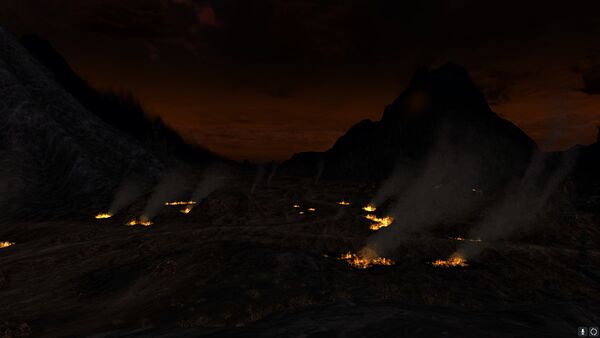
The Plateau of Gorgoroth is a Region in Mordor.
- Level: 105-115
- Factions: Conquest of Gorgoroth, Red Sky Clan, Allegiance System
- Crafting: T11 - Doomfold
- Introduced: The Lord of the Rings Online: Mordor, July 31, 2017
- Quest Pack:
 Expansion Content: Mordor
Expansion Content: Mordor - As you enter Mordor the game introduces a new mechanic called Shadow of Mordor. This shadow will greatly impact where you're able to go and how you get there.
- See The Plateau of Gorgoroth for more details
The Wastes
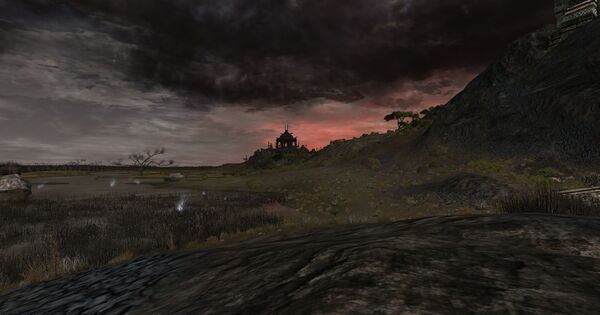
- See The Wastes for more details
The Wastes is a region that is situated immediately outside of Morannon, the Black Gate of Mordor. It lies above North Ithilien and north-west of Mordor. The is the site of a major battle at the end of the Second Age, when Mordor was first defeated, but the area was lost as Mordor regained strength. It has been long contested and is still occupied by Orcs and others ready to resist the march of the King.
- Level: 105
- Factions: Host of the West
- Crafting: Anórien (T10)
- Introduced: Update 20 - Battle of the Black Gate - March 21, 2017
- Free to VIP
- Quest Pack:
 Quest Pack: Battle of the Black Gate
Quest Pack: Battle of the Black Gate
| Settlements, Areas and Landmarks of The Wastes
| ||
|---|---|---|
| Areas: | Dagorlad (Morannon (War of the Last Alliance)) • (Lang Rhuven) • The Noman-lands • The Slag-hills (Battle of the Morannon) | |
| Settlements: | Camp of the Host • Haerondir • Small Ranger Camp | |
| Landmarks: | Tham Durlan • Nuiharn • Guard Tower Ruins • Store House Ruins • Merchant shop Ruins • Farm House Ruins • Inn Ruins • Noble's House Ruins • Stable Ruins • Carchost • Dol Acharn • Dûm Boha • Fushaum Gund • Narchost • Ondoher's Folly | |
| Interiors: | — | |
| Dungeons: | Skoironk • Towers of the Teeth | |
| Instances: | — | |
| Lands of Middle-earth
| ||
|---|---|---|
| Eriador • Gondor • Haradwaith • Mordor • Rhovanion • Rohan |
| Regions within the Land of Mordor
| ||
|---|---|---|
| Mordor Besieged • Morgul Vale • The Plateau of Gorgoroth |
References
- ↑ From the original Lorebook, offical Lore entry: https://web.archive.org/web/20100414192124/https://lorebook.lotro.com:80/wiki/Lore:Udûn_(stronghold_of_Melkor)
- ↑ J.R.R. Tolkien, The Lord of the Rings, "Index"
- ↑ a b c Evils of Udûn
- ↑ Chapter 1.2: The Cruel History of Durthang
- ↑ An Adventurer's Guide to Mordor; OMG_Peanuts; https://forums-old.lotro.com/forums/showthread.php?656588-An-Adventurer-s-Guide-to-Mordor
- ↑ Chapter 5.1: A Question of Purpose
- ↑ J.R.R. Tolkien, The Lord of the Rings, The Return of the King, "Mount Doom"
- ↑ Chapter 1.4: Ayorzén, Twice-Imprisoned
Guides
- Several individuals have wirtten guides for the Allegiance System, Questing in Mordor and other aspects of Update 21, the Mordor Expansion, in General.
LOTRO PLayers
- Allegiance, why, where, how and what for? - Squirle - LOTRO Players
- Mordor dailies and how to unlock - Squirle - LOTRO Players
Dadi's LOTRO Guides
- U21: Mordor – Light/Shadow System (Radiance 2.0) - Dadi's LOTRO Guides
- U21: Mordor – Ash of Gorgoroth Guide
- U21 Mordor: Stat Caps
- U21: Mordor – Gearing For Success
LOTRO.com Forum
- An Adventurer's Guide to Mordor - OMG Peanuts
Category Overview
Lore
- After the destruction of the strongholds of evil in the north of Middle-earth at the end of the First Age, Sauron fled southwards seeking new lands. At the end of the first millennium of the Second Age, he chose a land walled by mountains and there built his great fortress of Barad-dûr. To further fortify that land, to prevent invasion through the Pass of Cirith Gorgor he built the Morannon. It was built with the power of the One Ring, like his great fortress of Barad-dûr.
- After Sauron settled there, the land became known as Mordor (the Black Land) - no record of an earlier name for this region exists.
- At the end of the Second Age, after the defeat of Sauron by The Last Alliance of Elves and Men, Mordor was taken under the control of Gondor, and the Gondorians built fortifications around the Morannon, the Towers of the Teeth, to prevent the return of evil things. As Gondor's power faded, however, Mordor once again fell into the hands of the Enemy, and after two thousand years of relative peace, the Nazgûl returned and claimed the land once again in the name of Sauron. Sauron himself, however, dwelt at Dol Guldur in Mirkwood as the Necromancer, and did not himself return openly to Barad-dûr until some seventy years before the War of the Ring. The Nazgûl claimed Minas Ithil as their own, renaming it Minas Morgul.
- In the War of the Ring, Sauron's power was finally defeated when the One Ring was cast into the Crack of Doom, and the land of Mordor once again came under the control of the South-kingdom.
- Frodo and Sam traveled through Mordor enroute to find the Crack of Doom in order to destroy the One Ring in the fires where it was forged.
The History of Mordor
| :: The content of this section is based upon the Official Lore Entry in the LOTRO Lorebook (no longer on-line). |
Dates: Founded c. II 1000; under Gondorian control between II 3441 and c. III 1980; Sauron finally ejected in III 3019 Location: Directly to the east of Gondor Pronunciation: morr'dorr (all the 'r's should pronounced - 'rr' is used here to emphasise this) Meaning: 'Black (or Dark) Land' Other Names: The Black Land, The Dark Country, The Dark Land
C. II 1000 to II 3262
- Mordor is not mentioned in the histories of Middle-earth before the end of the first millennium of the Second Age[2], when Sauron chose it as his dwelling place. While its natural defences must have influenced his decision, we are told that the main reason for his choice was Orodruin, the great volcano that lay in the central regions of the Plateau of Gorgoroth, and which Sauron used in his sorcery, including the forging of the One Ring.
- Through the rest of the Second Age, Mordor became a base for Sauron's struggle for power in Middle-earth. Though he had many successes in this struggle, at one time controlling all of Eriador, he also suffered many setbacks at the hands of the Elves and, especially, the Númenóreans. The worst of these reverses came in 3262 (Second Age) when Ar-Pharazôn, the last King of Númenor, landed in Middle-earth with an unstoppable army. Sauron's forces fled, and he offered himself as hostage to Ar-Pharazôn, leaving Mordor and travelling with the victorious Númenóreans back to their island home.
- We are told little of Mordor after Sauron left it - his armies having fled, it must have been an empty, barren place for a time. Eventually, though, some part of his followers seem to have returned. After the destruction of Númenor and the founding of Gondor by Elendil and his sons, one of their first works was the building of Minas Ithil at the feet of the Ephel Dúath as a threat to Mordor, which suggests that even with Sauron absent, the remaining inhabitants of the Black Land posed a threat of their own.
II 3320 to II 3441
- Sauron himself secretly returned to the Black Land after the Downfall of Númenor, and the Gondorians were apparently unaware of this for a time. Soon, though, Orodruin burst into life once more, and the Men of Gondor understood that the Dark Lord had returned to Barad-dûr.
- After more than a century, in 3429, Sauron had rebuilt his armies sufficiently to contemplate an assault on the newly founded kingdom of Gondor on his western borders. He attacked and took Minas Ithil, but Isildur (who dwelt there at that time), escaped and fled north to his father in Arnor.
- Sauron's stroke was mistimed, for he was not yet strong enough to capture Osgiliath, Gondor's capital, and this gave Elendil the time to forge a military alliance with his friend Gil-galad. Elendil and Gil-galad marched with the host of this Last Alliance to the gates of Mordor, where they worsted Sauron in a mighty battle on the plain afterwards called the Dagorlad. There followed the seven-year Siege of Barad-dûr, but the forces of the Last Alliance eventually captured the Dark Tower, razed it to its foundations, and consigned Sauron to the shadows.
III 1 to c. III 1980
- Through some two thousand years of the Third Age, Mordor was a deserted and empty land, under the control of the Gondorians (although none of that people dwelt there). As time passed, though, and the power and might of Gondor dwindled, the watch on the borders of Mordor was relaxed.
- In 1975 (Third Age), the Battle of Fornost was fought in the north, and the forces of Angmar were defeated. The Witch-king of Angmar (the Lord of the Nazgûl) fled into the south and entered Mordor, taking it again in the name of Sauron and gathering the others of his order there. The Gondorian watch on Mordor had not been maintained, and after the Dark Plague some three hundred years earlier, Minas Ithil and the other forts and castles on Mordor's borders stood empty. This made the Nazgûl's return all the easier.
c. III 1980 to III 3019
- Soon after their return, the Nazgûl attacked Minas Ithil, and took it once again. This was in the year 2000, twenty years after their return, and Minas Ithil withstood a two-year siege before it fell. We know the Tower was unmanned in 1980, so we must assume that the Gondorians had quickly garrisoned the city once they learned of the Nazgûl's return - this makes sense when we consider that the King of Gondor at that time was Eärnil II, who was a great general before he became King.
- After its capture, Minas Ithil was renamed Minas Morgul, the Tower of Sorcery, and so the ancient dwelling of Isildur became a dark place and a threat to the Gondorians who had built it two thousand years before.
- For a thousand years, Mordor was to be ruled in Sauron's stead by the Lord of the Nazgûl. Sauron himself was slowly and secretly growing in power at Dol Guldur to the north, and did not wish to reveal himself until he had sufficient strength to face his enemies.
- By 2941 (Third Age), Sauron had grown sufficiently to face his foes. The White Council attacked Dol Guldur, but he had prepared for this and abandoned that stronghold, returning to his ancient kingdom of Mordor in the following year. He rebuilt his capital of Barad-dûr (whose foundations, made with the power of the Ring, had remained intact) and began the ordering of Mordor for war.
- That war, the War of the Ring, was to see his final downfall. In its closing days, an army of Gondor stood before the Morannon and challenged him, and he sent overwhelming forces to answer their challenge. Secure in the certainty of his victory, he was unaware that two Hobbits, Frodo Baggins and Samwise Gamgee, had secretly entered Mordor over the Ephel Dúath with the One Ring. Travelling across Gorgoroth, they reached Orodruin where the Ring was destroyed, bringing Sauron's rule to an end and leaving Mordor once again a desolate land under the control of Gondor.
Footnotes
Maps

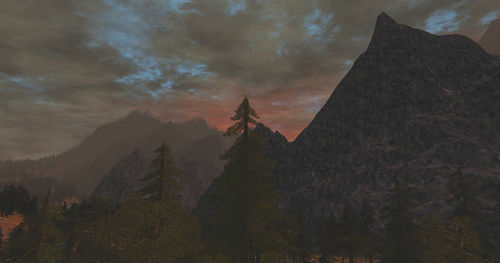
Cite error: <ref> tags exist for a group named "note", but no corresponding <references group="note"/> tag was found